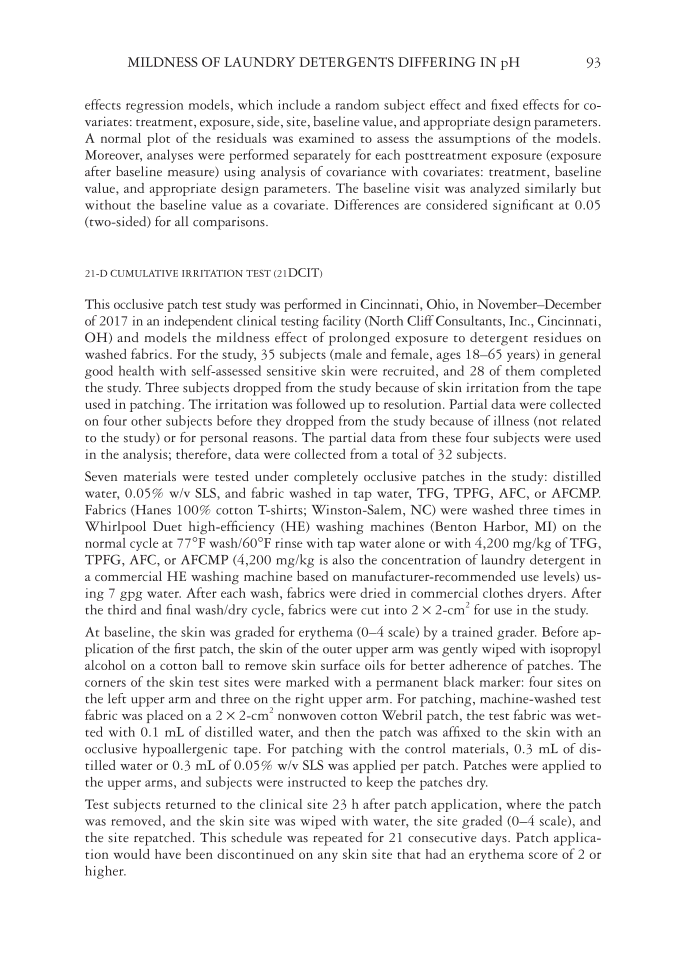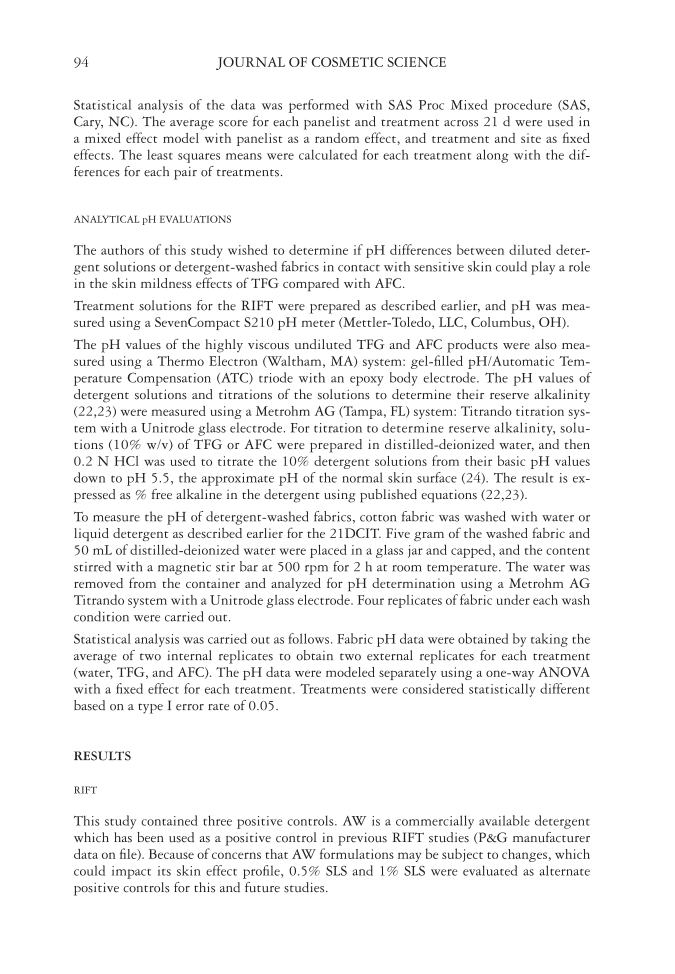MILDNESS OF LAUNDRY DETERGENTS DIFFERING IN pH 93 effects regression models, which include a random subject effect and fi xed effects for co- variates: treatment, exposure, side, site, baseline value, and appropriate design parameters. A normal plot of the residuals was examined to assess the assumptions of the models. Moreover, analyses were performed separately for each posttreatment exposure (exposure after baseline measure) using analysis of covariance with covariates: treatment, baseline value, and appropriate design parameters. The baseline visit was analyzed similarly but without the baseline value as a covariate. Differences are considered signifi cant at 0.05 (two-sided) for all comparisons. 21-D CUMULATIVE IRRITATION TEST (21DCIT) This occlusive patch test study was performed in Cincinnati, Ohio, in November–December of 2017 in an independent clinical testing facility (North Cliff Consultants, Inc., Cincinnati, OH) and models the mildness effect of prolonged exposure to detergent residues on washed fabrics. For the study, 35 subjects (male and female, ages 18–65 years) in general good health with self-assessed sensitive skin were recruited, and 28 of them completed the study. Three subjects dropped from the study because of skin irritation from the tape used in patching. The irritation was followed up to resolution. Partial data were collected on four other subjects before they dropped from the study because of illness (not related to the study) or for personal reasons. The partial data from these four subjects were used in the analysis therefore, data were collected from a total of 32 subjects. Seven materials were tested under completely occlusive patches in the study: distilled water, 0.05% w/v SLS, and fabric washed in tap water, TFG, TPFG, AFC, or AFCMP. Fabrics (Hanes 100% cotton T-shirts Winston-Salem, NC) were washed three times in Whirlpool Duet high-effi ciency (HE) washing machines (Benton Harbor, MI) on the normal cycle at 77°F wash/60°F rinse with tap water alone or with 4,200 mg/kg of TFG, TPFG, AFC, or AFCMP (4,200 mg/kg is also the concentration of laundry detergent in a commercial HE washing machine based on manufacturer-recommended use levels) us- ing 7 gpg water. After each wash, fabrics were dried in commercial clothes dryers. After the third and fi nal wash/dry cycle, fabrics were cut into 2 × 2-cm2 for use in the study. At baseline, the skin was graded for erythema (0–4 scale) by a trained grader. Before ap- plication of the fi rst patch, the skin of the outer upper arm was gently wiped with isopropyl alcohol on a cotton ball to remove skin surface oils for better adherence of patches. The corners of the skin test sites were marked with a permanent black marker: four sites on the left upper arm and three on the right upper arm. For patching, machine-washed test fabric was placed on a 2 × 2-cm2 nonwoven cotton Webril patch, the test fabric was wet- ted with 0.1 mL of distilled water, and then the patch was affi xed to the skin with an occlusive hypoallergenic tape. For patching with the control materials, 0.3 mL of dis- tilled water or 0.3 mL of 0.05% w/v SLS was applied per patch. Patches were applied to the upper arms, and subjects were instructed to keep the patches dry. Test subjects returned to the clinical site 23 h after patch application, where the patch was removed, and the skin site was wiped with water, the site graded (0–4 scale), and the site repatched. This schedule was repeated for 21 consecutive days. Patch applica- tion would have been discontinued on any skin site that had an erythema score of 2 or higher.
JOURNAL OF COSMETIC SCIENCE 94 Statistical analysis of the data was performed with SAS Proc Mixed procedure (SAS, Cary, NC). The average score for each panelist and treatment across 21 d were used in a mixed effect model with panelist as a random effect, and treatment and site as fi xed effects. The least squares means were calculated for each treatment along with the dif- ferences for each pair of treatments. ANALYTICAL pH EVALUATIONS The authors of this study wished to determine if pH differences between diluted deter- gent solutions or detergent-washed fabrics in contact with sensitive skin could play a role in the skin mildness effects of TFG compared with AFC. Treatment solutions for the RIFT were prepared as described earlier, and pH was mea- sured using a SevenCompact S210 pH meter (Mettler-Toledo, LLC, Columbus, OH). The pH values of the highly viscous undiluted TFG and AFC products were also mea- sured using a Thermo Electron (Waltham, MA) system: gel-fi lled pH/Automatic Tem- perature Compensation (ATC) triode with an epoxy body electrode. The pH values of detergent solutions and titrations of the solutions to determine their reserve alkalinity (22,23) were measured using a Metrohm AG (Tampa, FL) system: Titrando titration sys- tem with a Unitrode glass electrode. For titration to determine reserve alkalinity, solu- tions (10% w/v) of TFG or AFC were prepared in distilled-deionized water, and then 0.2 N HCl was used to titrate the 10% detergent solutions from their basic pH values down to pH 5.5, the approximate pH of the normal skin surface (24). The result is ex- pressed as % free alkaline in the detergent using published equations (22,23). To measure the pH of detergent-washed fabrics, cotton fabric was washed with water or liquid detergent as described earlier for the 21DCIT. Five gram of the washed fabric and 50 mL of distilled-deionized water were placed in a glass jar and capped, and the content stirred with a magnetic stir bar at 500 rpm for 2 h at room temperature. The water was removed from the container and analyzed for pH determination using a Metrohm AG Titrando system with a Unitrode glass electrode. Four replicates of fabric under each wash condition were carried out. Statistical analysis was carried out as follows. Fabric pH data were obtained by taking the average of two internal replicates to obtain two external replicates for each treatment (water, TFG, and AFC). The pH data were modeled separately using a one-way ANOVA with a fi xed effect for each treatment. Treatments were considered statistically different based on a type I error rate of 0.05. RESULTS RIFT This study contained three positive controls. AW is a commercially available detergent which has been used as a positive control in previous RIFT studies (P&G manufacturer data on fi le). Because of concerns that AW formulations may be subject to changes, which could impact its skin effect profi le, 0.5% SLS and 1% SLS were evaluated as alternate positive controls for this and future studies.
Purchased for the exclusive use of nofirst nolast (unknown) From: SCC Media Library & Resource Center (library.scconline.org)

















































